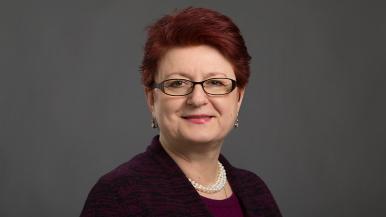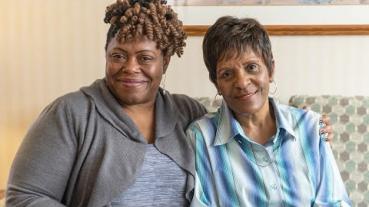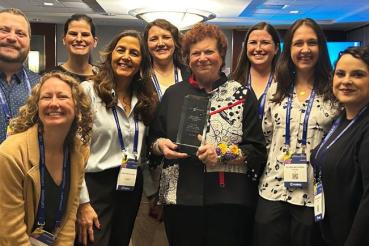For caregivers, placing a loved one with dementia into a long-term care facility can take just as much of an emotional toll as caring for that individual at home. The COVID-19 pandemic certainly hasn’t made the burden any easier.
The nursing home industry in the age of COVID-19 is “ravaged at the core,” says Olimpia Paun, PhD, PMHCNS-BC, a Rush University College of Nursing professor. Paun is conducting research aimed at lightening the emotional burden of caregivers who have placed their loved ones in nursing homes due to Alzheimer’s disease and related dementia, or ADRD. She says approximately 40% of all people who die from coronavirus lived in nursing facilities, and that risk has only ramped up the anguish family members are feeling.
Some of the caregivers who have participated in Paun's research have lost loved ones to the virus, have become sick themselves or have been unable to visit the facility for months due to COVID-19 restrictions.
One woman Paun knows fell off a ledge when she climbed a wall to catch a glimpse of her mother through the window of her nursing home. Her mother later died.
“Caregivers' grief is exacerbated by the lack of physical contact with their loved ones,” Paun says. “I have heard a great deal of frustration and anxiety in my research’s group sessions in the COVID-19 era.”
Caring for caregivers
Of the more than 43 million caregivers in the U.S., nearly 16 million of them provide care at home for family members with ADRD. For many, placing a loved one in a long-term care facility is a late, sad phase of a long journey that occurs when the caregiver is no longer up to the job, or can no longer safely care for the person with ADRD at home. Three-quarters of people with ADRD spend their last days in long-term care.
“Placing loved ones in long-term care may ease the physical burden,” Paun says. “But emotionally, caregivers are torn with guilt.”
Paun is testing an online, group-based program she has developed, the Chronic Grief Management Intervention-Video, or CGMI-V, to help people handle the emotional weight of moving a loved one to long-term care.
CGMI-V comprises eight one-hour video classes designed to enhance caregivers' knowledge of end-stage ADRD, as well as their ability to communicate, manage interpersonal conflict and their own feelings. Paun is planning to enroll 144 participants in a clinical trial of CGMI-V. Half will use the program; the other half, the control group, will receive written information about ADRD and other resources. Approximately 60 participants are already enrolled in the study.
Research has shown that depression, anxiety and chronic grief typically increase in family caregivers after a family member is placed in long-term care. Other research has shown that ADRD caregivers who have a high level of grief while their family members are alive are even more grief-stricken seven months after the person dies, which suggests the importance of addressing these feelings early. CGMI-V has been shown to reduce many of these negative emotions.
‘An ambiguous loss’
The caregivers Paun has interviewed over the years often talk about how guilty they feel for placing a loved one in a nursing home. As destructive and extensive as the guilt can be, Paun says chronic grief is at the heart of the issue. That was an epiphany for her when she began this project 13 years ago. Paun immersed herself in the research literature of grief and sought out experts in the field, and CGMI-V reflects her findings.
Grief is normal for anyone who loses a loved one, but losing someone to dementia generates a “complicated grief, an ambiguous loss” due to the nature of the disease, Paun says. (Pauline Boss, PhD, professor emeritus at the University of Minnesota, first coined the term “ambiguous loss” in the 1970s.)
Left untreated, prolonged grief takes a toll on physical health and quality of life, Paun says.
Caregivers grieve the loss of their family members' abilities, and their relationships with them, all along the trajectory of the disease,” she says. “They feel it more intensely once they place their loved one in long-term care.
Paun says spouses don’t typically place a patient in long-term care. Most of the family members she works with are adult children. “They constantly worry about their loved one’s well-being,” she says. “They describe this as a permanent state of mind.”
Many caregivers are stressed, take medication for anxiety or depression, and seek mental health services. A major stressor is watching their loved ones be cared for by others in a setting outside the home.
“They become advocates for maintaining their family members' dignity in that long-term care setting,” Paun says. Many family caregivers take on weighty health and financial decisions, including “navigating the financial challenges associated with the cost of long-term care,” she says.
Tailoring a video intervention
Paun and her research team developed CGMI first in 2008 as a 12-week, in-person class led by professionals and designed to enhance family members' knowledge about late-stage dementia communication and conflict-resolution skills, and to process loss and grief. The group setting gives participants a chance to get professional support and share experiences with people in similar situations. The interventions significantly improved caregivers’ knowledge, and decreased their guilt and loneliness. Levels of guilt remained low for the intervention group six months later.
Early participants suggested fewer sessions would be a better fit with their busy lives. So Paun's team compressed the material into eight video sessions online, with everyone using iPads and the same video software for consistency of access. In 2017, Paun tested the feasibility of the shorter online version, and discovered that it was as effective as the longer in-person program in helping people process their guilt and grief.
Paun’s latest study will gauge the effectiveness of CGMI-V in reducing grief, depression and anxiety, encouraging positive feelings, and enhancing knowledge about late-stage ADRD and communication skills — for example, how to advocate for relatives with nursing-home staff.
‘It all goes back to my experience as a child’
Paun, who grew up in Bucharest in her native Romania, earned a master's degree in education and French from the University of Bucharest. She’s passionate about literature. When she came to the United States with her family in 1986, though, an American friend advised her to look into a nursing career.
“‘A nurse will always have a job in the States,’” she recalls the friend telling her.
Paun took that advice to heart. She first became a registered nurse before finding her way to psychiatric gerontological nursing and research.
But she still cherishes a good tale, which is one reason she specializes in working with older people, she says. She loves to hear their stories.
“It all goes back to my experience as a child,” Paun says. “I slept in the same bed with my maternal grandmother for 10 years. It sounds odd to Americans, but it was customary in Romania. I had such a bond with my grandmother. She told me a story every night. Everything was at peace when I was next to her.” She was close to her paternal grandparents as well, she says.
After getting a bachelor's degree in nursing at the University of Oklahoma in Oklahoma City, Paun moved to Chicago in 1990 and got both her master’s and PhD degrees from the University of Illinois at Chicago. She then completed postdoctoral studies at Rush with Carol Farran, DNSc, RN, professor emeritus, with a John A. Hartford Foundation Claire M. Fagin Fellowship.
As a PhD candidate, Paun interviewed 14 women who were caring for their husbands with ADRD at home. She was surprised to find that the women had made a clear choice to take on that responsibility. She even spoke with one woman who was caring for the husband from whom she was separated. “I look at him as a human being” in need, the woman told Paun.
She began working at Rush as a clinician in 1992 and became a Rush University College of Nursing faculty member in 2002. Her goals include mentoring nurses — “always” — and helping them learn to love older adults as much as she does.
“We work as a team,” she says. “But part of my own mission is to instill interest in this population in a new generation of nurses.”




